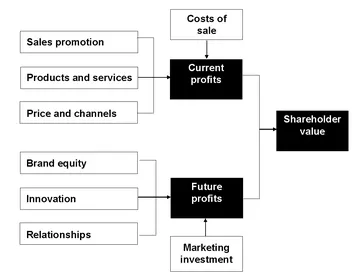![]()
Leading: The impact of a marketing genius
PART 4
Leading: The impact of a marketing genius
• What is the real measure of marketing success? How do you lead and manage marketing activities in a more powerful and profitable way? How do you articulate the real value of marketing to boardrooms and investors?
• How do you measure marketing performance? How do you reconcile the short and long-term impact? How do you get more out of your budgets? And how do you articulate your value to the business and shareholders?
• What is the role of today’s marketer? How can marketers become more strategic, innovative and commercial? How do they market for maximum impact and ensure that their promises become reality?
• How do you lead marketing and marketers? What does it take to be a Chief Marketing Officer (CMO)? What are the different roles functionally and across the business? And how do you become the next CEO?
• What is the emerging world of marketing? Indeed how are markets, customers and business changing, and how should we anticipate and respond? And what is it that really inspires extraordinary results?
‘The people who get on in this world are the people who get up and look for the circumstances they want, and, if they can’t find them, make them.’
![]()
TRACK 12 PERFORMANCE
Unlocking the real value of marketing
‘Whenever you see a successful business, someone once made a courageous decision.’
‘Of the five business deadly sins, the first and easily the most common is the worship of high profit margins.’
Marketing is the most important driver of economic value creation. It is also often the largest discretionary spend in business, so how do you ensure that it really delivers? For too long, marketing has been perceived to be unaccountable, unfocused and indisciplined in connecting its creative executions with business performance.
While the outcome of marketing may seem obvious - increased sales - many a marketing director has survived and thrived on the wave of advertising that is beautiful and emotive, even if nobody has any idea whether it actually delivers incremental sales, or any other improved results.
Even if you do know that it has a financial impact, there is no guarantee that consumer preference will convert ultimately into stock market performance. Taking great rivals Coca-Cola and Pepsi, for example, numerous research studies have shown that while more people like the taste of Pepsi, they prefer to buy the Coke brand. Similarly, despite the higher sales revenues of Pepsi worldwide, analysts and investors have more confidence in the future cash flows of Coke (or, more precisely, The Coca-Cola Company over Pepsico). Brands therefore have a significant impact on investors as well as consumers.
Source: Data from Bloomberg and Leslie de Chateney
Measuring marketing performance through a focus on the most significant ‘metrics’ enables you to:
• demonstrate the ROI on the business’s largest discretionary spend;
• distinguish short- and long-term impacts of marketing;
• improve activities through adjustment as initial results come in;
• focus the efforts of creative and ill-disciplined marketers;
• provide a useful lead indicator of future business performance;
• improve the respect for and influence of marketers across the business; and
• engage business leaders in marketing and its business impact.
Most marketers realize this, although many still do not appreciate the financial significance of getting it right. While marketers might be tempted to focus on the creativity and see measurement as a bolt-on at the end, measurement itself can make a significant and rapid impact on performance by influencing the upfront decisions - targeting, designing and prioritizing actions.
‘CEOs are understandably growing impatient with marketing. They feel that they get accountability for their investments in finance, production, IT, even purchasing, but they don’t know what their marketing spending is achieving.’
Marketing and the CEO:
Why CEOs are fed up with Marketing, Philip Kotler
Indeed, according to an ANA/Booz Allen Hamilton study, clearly entitled ‘Marketing Department Priorities Often Differ from CEOs’ Agenda’, marketing is considered a critical business function but the lack of actionable metrics has removed it from the CEO’s agenda. Their research indicates that 75% of senior executives agree that marketing is far more important than it was five years ago; however, most see it as increasingly disconnected from the business agenda.
Measurement and accountability again come out as critical. CEOs expect marketing to provide measurable outcomes like ROI, but see current metrics as detached and not up to the task: 66% of executives say that true ROI analytics are marketing’s greatest need, rather than relying on surrogate metrics like awareness and preference. Research by the CMO Council supports this, with 90% of respondents saying measuring marketing performance is a key priority, particularly in larger companies, and 80% saying they have no formal marketing performance measurement system - even when marketing spends 25% of the company’s revenues in some cases.
Some marketers have already spent much time addressing these challenges and recognize that they are not administrative distractions cramping the creative process but significant opportunities to improve the bottom line, and the credibility of marketing within the business.
‘Over the last two to three years, the value we have created for the company via our marketing accountability work is the equivalent of launching a new global brand the size of Tide.’
Jim Stengel, Global Marketing Officer, PEtG
ANA Marketing Accountability Summit, 9 September 2004
Even when marketing takes measurement seriously, it is still not easy to quantify the full impact of marketing’s efforts. The impact is diverse, affecting both current and future sales, and also other behaviours such as the propensity to pay more, buy more or tell others. All of these factors contribute to the real return on marketing investment.
Accounting does not help. Accounting statements are flawed at the best of times, but particularly in companies with high growth, where brand building and innovation are key. Such statements treat these strategic investments as expenses to be deducted from current profits, rather than considering the future profits which they will drive.
Such accountancy-driven behaviours discourage managers from investing in brands and innovation, despite them driving the future potential in which shareholders are most interested. This is why a value-based approach, one that considers cash, current and future, is so useful to marketing and marketers.
‘Marketing ROI’ has become the fashion that every marketer now feels they should be focused on, and every consulting firm wants to sell. Yet the majority of proponents are notoriously short sighted and, in a not dissimilar way from the hijacking of CRM, they see it as a piece of analytical software to plug in and somehow connect marketing spend as inputs and sales results as the outputs.
Of course, this might well be a step forward compared with no measures at all. However, if focused just on the short term, it is likely to reflect less than half of the true picture and, as a result, refocus marketing on short-term tactical sales promotions. This is both damaging to marketing, as it seeks to position itself as the strategic driver of business, and to the performance of business.
We should therefore consider marketing performance, including marketing ROI, more thoughtfully - the metrics that are most sensible to measure performance, the appropriate ways to optimize the outcomes, and how to articulate the results as part of internal and external business reporting to boardrooms and investors.
Inspiration 12.1 CADBURY SCHWEPPES
Cadbury Schweppes sets a clear framework of strategic intent, and how it will conduct business. Its core purpose is ‘working together to create brands people love’, while its objective is ‘to consistently deliver superior shareowner returns’.
While this goal is quite single-minded, it recognizes that it cannot be achieved in isolation - that the business also has obligations to consumers and customers, employees and society, communities and the environment. Indeed, the statements seek to capture the heritage and future of the business.
Two men, quite separately, provide the roots to the confectionery and drinks giant. In 1783, Swiss inventor Jacob Schweppe perfected a process for carbonating mineral water that was sourced from near his Geneva home. In 1824 John Cadbury opened a shop in Birmingham, England, selling cocoa and chocolate. The great names merged in 1969, and the business has grown ever since.
Acquisitions have been key to the growth over the last two decades - bringing together over 50 iconic brands such as Trebor, Bassett, Halls, Trident, 7 Up, Snapple, Orangina, Dr Pepper, Canada Dry and many more. The more recent purchase of Adams - bringing its large portfolio of US-based brands, and distribution network - makes Cadbury Schweppes the leader in the confectionery world, and the third largest soft drinks company.
In 1997 ‘Managing for Value’ was introduced by CEO John Sutherland, to focus the entire organization on the delivery of ‘superior shareowner returns’. As well as a far more rigorous approach to portfolio analysis, focusing on the markets and brands that delivered the best future cash flows, this also required a significant education process so that every person in the business understands the drivers of success. Production line workers, for example, were helped to understand the real meaning of economic profitability, and why returns needed to exceed the cost of capital.
In 2003, a new set of goals and performance me...



